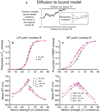Microstimulation of macaque area LIP affects decision-making in a motion discrimination task
- PMID: 16604069
- PMCID: PMC2770004
- DOI: 10.1038/nn1683
Microstimulation of macaque area LIP affects decision-making in a motion discrimination task
Abstract
A central goal of cognitive neuroscience is to elucidate the neural mechanisms underlying decision-making. Recent physiological studies suggest that neurons in association areas may be involved in this process. To test this, we measured the effects of electrical microstimulation in the lateral intraparietal area (LIP) while monkeys performed a reaction-time motion discrimination task with a saccadic response. In each experiment, we identified a cluster of LIP cells with overlapping response fields (RFs) and sustained activity during memory-guided saccades. Microstimulation of this cluster caused an increase in the proportion of choices toward the RF of the stimulated neurons. Choices toward the stimulated RF were faster with microstimulation, while choices in the opposite direction were slower. Microstimulation never directly evoked saccades, nor did it change reaction times in a simple saccade task. These results demonstrate that the discharge of LIP neurons is causally related to decision formation in the discrimination task.
Figures






Similar articles
-
Neural activity in macaque parietal cortex reflects temporal integration of visual motion signals during perceptual decision making.J Neurosci. 2005 Nov 9;25(45):10420-36. doi: 10.1523/JNEUROSCI.4684-04.2005. J Neurosci. 2005. PMID: 16280581 Free PMC article.
-
Signal multiplexing and single-neuron computations in lateral intraparietal area during decision-making.J Neurosci. 2013 Feb 6;33(6):2254-67. doi: 10.1523/JNEUROSCI.2984-12.2013. J Neurosci. 2013. PMID: 23392657 Free PMC article.
-
Neural Mechanisms of Post-error Adjustments of Decision Policy in Parietal Cortex.Neuron. 2016 Feb 3;89(3):658-71. doi: 10.1016/j.neuron.2015.12.027. Epub 2016 Jan 21. Neuron. 2016. PMID: 26804992 Free PMC article.
-
Saccades, salience and attention: the role of the lateral intraparietal area in visual behavior.Prog Brain Res. 2006;155:157-75. doi: 10.1016/S0079-6123(06)55010-1. Prog Brain Res. 2006. PMID: 17027387 Free PMC article. Review.
-
[Parietal Association Area and Motion Information Processing].Brain Nerve. 2016 Nov;68(11):1335-1343. doi: 10.11477/mf.1416200597. Brain Nerve. 2016. PMID: 27852024 Review. Japanese.
Cited by
-
Evidence accumulation during a sensorimotor decision task revealed by whole-brain imaging.Nat Neurosci. 2020 Jan;23(1):85-93. doi: 10.1038/s41593-019-0535-8. Epub 2019 Dec 2. Nat Neurosci. 2020. PMID: 31792463
-
Ongoing, rational calibration of reward-driven perceptual biases.Elife. 2018 Oct 10;7:e36018. doi: 10.7554/eLife.36018. Elife. 2018. PMID: 30303484 Free PMC article.
-
Decision threshold modulation in the human brain.J Neurosci. 2010 Oct 27;30(43):14305-17. doi: 10.1523/JNEUROSCI.2371-10.2010. J Neurosci. 2010. PMID: 20980586 Free PMC article.
-
Neurally constrained modeling of perceptual decision making.Psychol Rev. 2010 Oct;117(4):1113-43. doi: 10.1037/a0020311. Psychol Rev. 2010. PMID: 20822291 Free PMC article.
-
Working memory retrieval as a decision process.J Vis. 2014 Feb 3;14(2):2. doi: 10.1167/14.2.2. J Vis. 2014. PMID: 24492597 Free PMC article.
References
-
- de Lafuente V, Romo R. Neuronal correlates of subjective sensory experience. Nat Neurosci. 2005;8:1698–1703. - PubMed
-
- Schall J, Thompson K. Neural selection and control of visually guided eye movements. Annu Rev Neurosci. 1999;22:241–259. - PubMed
-
- Glimcher PW. The neurobiology of visual-saccadic decision making. Annu Rev Neurosci. 2003;26:133–179. - PubMed
-
- Romo R, Salinas E. Flutter discrimination: neural codes, perception, memory and decision making. Nat Rev Neurosci. 2003;4:203–218. - PubMed
-
- Pasternak T, Merigan WH. Motion perception following lesions of the superior temporal sulcus in the monkey. Cereb Cortex. 1994;4:247–259. - PubMed
Publication types
MeSH terms
Grants and funding
LinkOut - more resources
Full Text Sources
Other Literature Sources

